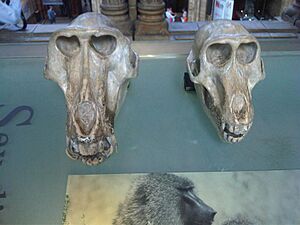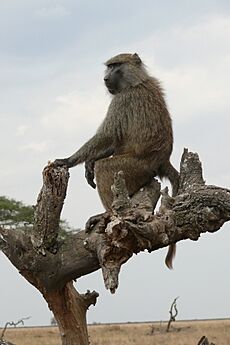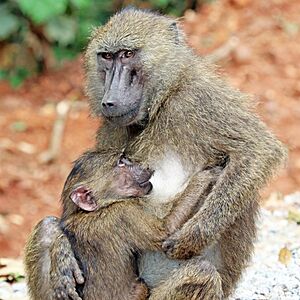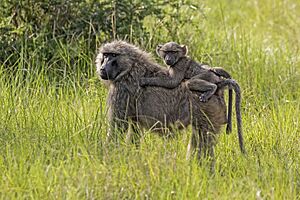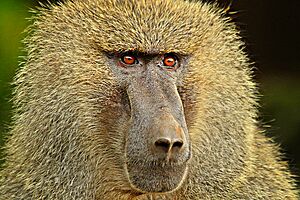Olive baboon facts for kids
Quick facts for kids Olive baboon |
|
|---|---|
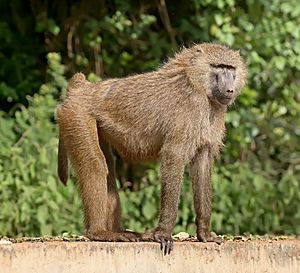 |
|
| In the Ngorongoro Conservation Area, Tanzania | |
| Conservation status | |
| Scientific classification | |
| Genus: |
Papio
|
| Species: |
anubis
|
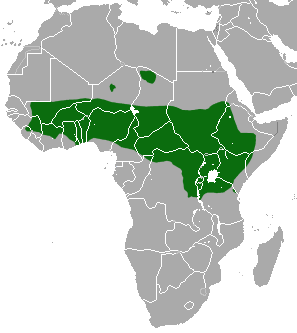 |
|
| Geographic range | |
The olive baboon (Papio anubis), also known as the Anubis baboon, is a type of Old World monkey. It belongs to the family Cercopithecidae. This baboon species lives in more places than any other baboon. You can find them in 25 countries across Africa, from Mali in the west to Ethiopia and Tanzania in the east. Some groups also live in the mountains of the Sahara desert. They make their homes in savannahs, steppes, and forests. Their name comes from their fur, which looks like a green-grey color from far away. Olive baboons use many different sounds and body language to communicate. This helps them have a complex social life.
Contents
What Makes Olive Baboons Special?
The olive baboon gets its name from its fur, which looks green-grey from a distance. Up close, their fur has many colors. This is because each hair has rings of yellow-brown and black. The hair on their face is rougher and can be dark grey or black. Both male and female baboons have these colors. However, males have a longer mane of hair around their neck and shoulders. This mane gets shorter along their back.
Besides the mane, male olive baboons are different from females in other ways. Males are usually bigger and heavier. They also have larger canine teeth. On average, males stand about 70 centimeters (27.5 inches) tall. Females are about 60 centimeters (23.6 inches) tall. Olive baboons are among the largest monkey species. Their body length, not including the tail, can be from 50 to 114 centimeters (19.7 to 44.9 inches). The average is around 85 centimeters (33.5 inches). Males weigh about 24 kilograms (53 pounds) on average, while females weigh about 14.7 kilograms (32.4 pounds). Some large males can weigh up to 50 kilograms (110 pounds).
Like other baboons, the olive baboon has a long, dog-like snout. Their tail is 38 to 58 centimeters (15 to 23 inches) long. When they walk on all fours, they can look like a dog. Their tail looks like it's broken because it stands up for the first part, then drops sharply down. Olive baboons have a smaller bare patch on their rump compared to some other baboon types. Like most monkeys in their group, they have cheek pouches. They use these pouches to store food.
Where Do Olive Baboons Live?
The olive baboon lives in a wide band across 25 countries in Africa. This area stretches almost from the east coast to the west coast. The exact edges of their territory are not always clear. This is because their land often overlaps with where other baboon species live. In many places, this leads to different baboon types having babies together. For example, olive baboons and hamadryas baboons often mix in Ethiopia. They have also been seen mixing with yellow baboons and Guinea baboons.
Olive baboons can live in many different places across their wide range. They are often known for living in savannahs, which are wide grasslands. These grasslands, especially near open forests, are a big part of their home. But these baboons also live in rainforests and even deserts. For instance, in Uganda and the Democratic Republic of the Congo, olive baboons live in thick tropical forests.
How Olive Baboons Live and Interact
Social Life of Baboons
Olive baboons live in groups that can have from 15 to 150 members. These groups include a few males, many females, and their young. A female's social rank is mostly passed down from her mother. Daughters usually get a similar rank to their mother. Adult females form the main part of the group's social system. Female relatives often create their own smaller groups within the larger troop. These related females are usually friendly with each other. They stay close, groom each other, and work together in fights within the group. Female relatives form strong bonds because they usually stay in the group where they were born.
Sometimes, very large groups might split up. This happens when there isn't enough food for everyone. Even then, family lines of females tend to stay together. Females with higher social ranks get more food, more chances to have babies, and more support from others. In Tanzania, high-ranking female baboons have babies more often. Their babies also have a better chance of surviving. Their daughters tend to grow up faster than those of lower-ranking females.
A female baboon often forms a lasting friendship with a male in her group. These friendships are not about mating. They help both the male and female. Males benefit because these friendships often start soon after they join a new group. This helps the male fit in more easily. He might also mate with his female friend later on. Females get protection from dangers to themselves and their babies. Males sometimes "babysit" for their female friends. This allows the female to find food without having to carry or watch her baby. These friendships can last a long time. The pair grooms each other and stays close. They also travel, find food, sleep, and raise babies together. They even fight together against other baboons.
High-ranking females can even have friendships with several males at once. These friendships also help females avoid unwanted attention from males who want to mate. If a female doesn't want to mate with a male, she can call on her male friends to chase him away. This gives her more control over who she mates with.
Males show their dominance more strongly than females. A male leaves his birth group and joins another group when he becomes an adult. Adult males compete a lot with each other for access to females. Being higher in rank means better access to mating and food. So, there's a lot of fighting for rank. Younger males are always trying to move up. Since females stay in their groups for life and males move, a new male often challenges an older one for dominance. When older baboons lose their high rank, they often move to another group. Younger males who pushed them down might bully them. Older males tend to have more supportive friendships than younger males. They might even team up against younger males.
Even though baboons have a clear social order, they seem to make decisions about where to go as a group. Individuals are more likely to follow when many baboons agree on a direction. They don't just follow the most dominant ones.
Reproduction and Life Cycle
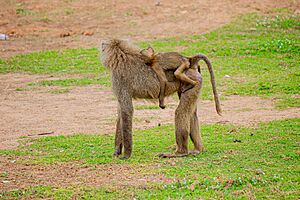
Female olive baboons can start having babies when they are seven to eight years old. Males are ready to mate at seven to 10 years old. When a female is ready to mate, her rear area swells and turns bright red or pink. This swelling makes it harder for her to move. Females with more swelling tend to have babies younger and more often. Their babies also have a better chance of surviving. These females also attract more males, which can lead to fights between the males. Olive baboons usually mate with many partners. A male will stay close to a female who is ready to mate and will mate with her. Males guard their partner from other males trying to mate. If a female is not with one male for several days, she often mates with more than one male each day. Mating with many males might make it unclear who the father is. This can help reduce the chance of males harming babies.
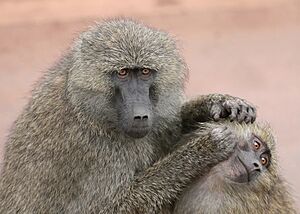
Newborn baboons have black fur and bright pink skin. Females are the main caregivers for their babies, but males also help. For the first few days, a baby might not be able to hold onto its mother. It relies on her to support it. By its first week, its grip gets stronger, and it can cling to its mother's fur by itself. After two weeks, the baby starts to explore nearby areas for short times. It always stays close to its mother. As the baby gets older, it spends more time away from its mother. Generally, high-ranking mothers are more relaxed parents. Lower-ranking mothers usually keep their babies closer. This difference lasts for about the first eight weeks of a baby's life.
Olive baboons don't seem to share parenting duties much. However, a female might groom a baby that isn't hers. Younger females, who haven't had their own babies yet, are more likely to care for other baboons' young. One idea is that this helps them prepare to be mothers themselves. Babies born to first-time mothers often don't survive as well as those born to experienced mothers. This suggests that practice in caring for babies is important. Adult males in the group also care for babies, especially if they are related to them. Males groom babies, which helps remove parasites. They also calm babies when they are stressed. They might also protect them from predators like chimpanzees. Adult males sometimes use babies as a shield to make other males less likely to threaten them during conflicts.
How Baboons Communicate
Olive baboons use many different sounds and facial expressions to talk to each other. All baboons, young and old, make a "basic grunt" throughout the day. Adult baboons have a range of calls. Adult males make a "roargrunt" when they are showing off to each other. They make a "cough-bark" or "cough geck" when they see low-flying birds or unfamiliar humans. A "wa-hoo" call is used for predators or nearby groups, especially at night or when they are stressed. Other sounds include "broken grunting" (quiet, quick grunts during calm arguments), "pant-grunts" (when arguments get more serious), "shrill barks" (loud calls for sudden dangers), and "screams" (continuous high-pitched sounds for strong feelings).
The most common facial expression is "lipsmacking." This is used with many behaviors. "Ear flattening," "eyes narrowed," "head shaking," "jaw-clapping," lipsmacking, and "tongue sticking out" are used when baboons greet each other. Sometimes they also present their rear. "Eyebrow raising," "molar grinding," "staring," and "yawning" are used to threaten other baboons. A baboon that wants to show it is not a threat might use a "fear grin," a "rigid crouch," or hold its "tail erect."
What Olive Baboons Eat
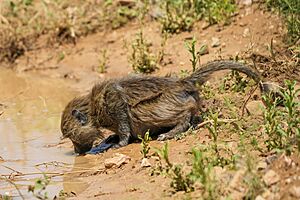
One big reason why olive baboons are so successful is that they eat almost anything. They are omnivores, meaning they eat both plants and animals. This allows them to find food in almost any environment. They can also change how they look for food. For example, a baboon in a grassland finds food differently than one in a forest. Baboons look for food everywhere: on the ground, underground, and in the trees. Most animals only look for food in one area. For example, a lemur that lives in trees usually doesn't look for food on the ground. The olive baboon searches a very wide area and eats almost everything it finds.
Their diet usually includes many different plants. They also eat invertebrates (like insects) and small mammals, as well as birds. Olive baboons eat leaves, grass, roots, bark, flowers, fruit, lichens, tubers, seeds, mushrooms, corms, and rhizomes. Corms and rhizomes are very important when there is a drought. This is because grass loses much of its food value then. In dry, desert areas, small invertebrates like insects, grubs, worms, spiders, and scorpions are a big part of their diet.
Olive baboons also actively hunt prey. This includes small rodents, birds, and other primates. They usually hunt small antelope, like Thomson's gazelle. They will also kill sheep, goats, and chickens from farms. Hunting is often a group activity, with both males and females taking part. This kind of hunting seems to have started more recently. In one study, this behavior began with the males of one group and then spread to all ages and sexes.
In Eritrea, olive baboons have a special relationship with the endangered elephants there. The baboons use the water holes that the elephants dig. In return, the elephants use the baboons in the trees as an early warning system for danger.
Are Olive Baboons Endangered?
The olive baboon is listed as "least concern" on the IUCN Red List. This means they are not currently in danger of disappearing. They live in many places and have a large population worldwide. Their numbers are not dropping across their entire range. However, competition and diseases might have led to fewer baboons in dense forests. Like most other baboon species, they are sometimes killed because they raid crops and hunt small farm animals.



